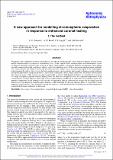Files in this item
A new approach for modelling chromospheric evaporation in response to enhanced coronal heating : I. The method
Item metadata
| dc.contributor.author | Johnston, Craig David | |
| dc.contributor.author | Hood, Alan William | |
| dc.contributor.author | Cargill, Peter | |
| dc.contributor.author | De Moortel, Ineke | |
| dc.date.accessioned | 2017-01-06T17:30:09Z | |
| dc.date.available | 2017-01-06T17:30:09Z | |
| dc.date.issued | 2017-01 | |
| dc.identifier | 245971370 | |
| dc.identifier | 41b4c03f-129c-414c-8daa-a534597b85f6 | |
| dc.identifier | 85009069280 | |
| dc.identifier | 000392392900089 | |
| dc.identifier.citation | Johnston , C D , Hood , A W , Cargill , P & De Moortel , I 2017 , ' A new approach for modelling chromospheric evaporation in response to enhanced coronal heating : I. The method ' , Astronomy & Astrophysics , vol. 597 , A81 , pp. 1-15 . https://doi.org/10.1051/0004-6361/201629153 , https://doi.org/10.1051/0004-6361/201629153 | en |
| dc.identifier.issn | 0004-6361 | |
| dc.identifier.other | BibCode: 2017A&A...597A..81J | |
| dc.identifier.other | BibCode: 2017A&A...597A..81J | |
| dc.identifier.other | ORCID: /0000-0002-1452-9330/work/39526521 | |
| dc.identifier.other | ORCID: /0000-0003-4023-9887/work/30257247 | |
| dc.identifier.other | ORCID: /0000-0003-2620-2068/work/58055128 | |
| dc.identifier.uri | https://hdl.handle.net/10023/10063 | |
| dc.description | C.D.J. acknowledges the financial support of the Carnegie Trust for the Universities of Scotland. This project has received funding from the Science and Technology Facilities Council (UK) through the consolidated grant ST/N000609/1 and the European Research Council (ERC) under the European Union’s Horizon 2020 research and innovation program (grant agreement No 647214). | en |
| dc.description.abstract | We present a new computational approach that addresses the difficulty of obtaining the correct interaction between the solar corona and the transition region in response to rapid heating events. In the coupled corona, transition region and chromosphere system, an enhanced downward conductive flux results in an upflow (chromospheric evaporation).However, obtaining the correct upflow generally requires high spatial resolution in order to resolve the transition region. With an unresolved transition region, artificially low coronal densities are obtained because the downward heat flux ‘jumps’ across the unresolved region to the chromosphere, underestimating the upflows. Here, we treat the lower transition region as a discontinuity that responds to changing coronal conditions through the imposition of a jump condition that is derived from an integrated form of energy conservation. To illustrate and benchmark this approach against a fully resolved one-dimensional model, we present field-aligned simulations of coronal loops in response to a range of impulsive (spatially uniform) heating events. We show that our approach leads to a significant improvement in the coronal density evolution than just when using coarse spatial resolutions insufficient to resolve the lower transition region. Our approach compensates for the jumping of the heat flux by imposing a velocity correction that ensures that the energy from the heat flux goes into driving the transition region dynamics, rather than being lost through radiation. Hence, it is possible to obtain improved coronal densities. The advantages of using this approach in both one-dimensional hydrodynamic and three-dimensional magnetohydrodynamic simulations are discussed. | |
| dc.format.extent | 15 | |
| dc.format.extent | 1323534 | |
| dc.language.iso | eng | |
| dc.relation.ispartof | Astronomy & Astrophysics | en |
| dc.subject | Sun: corona | en |
| dc.subject | Sun: magnetic fields | en |
| dc.subject | Magnetohydrodynamics (MHD) | en |
| dc.subject | Sun: chromosphere | en |
| dc.subject | QB Astronomy | en |
| dc.subject | QC Physics | en |
| dc.subject | NDAS | en |
| dc.subject | BDC | en |
| dc.subject | SDG 7 - Affordable and Clean Energy | en |
| dc.subject.lcc | QB | en |
| dc.subject.lcc | QC | en |
| dc.title | A new approach for modelling chromospheric evaporation in response to enhanced coronal heating : I. The method | en |
| dc.type | Journal article | en |
| dc.contributor.sponsor | Science & Technology Facilities Council | en |
| dc.contributor.sponsor | European Research Council | en |
| dc.contributor.institution | University of St Andrews. Applied Mathematics | en |
| dc.contributor.institution | University of St Andrews. School of Mathematics and Statistics | en |
| dc.identifier.doi | 10.1051/0004-6361/201629153 | |
| dc.description.status | Peer reviewed | en |
| dc.identifier.url | http://adsabs.harvard.edu/abs/2017A%26A...597A..81J | en |
| dc.identifier.grantnumber | ST/N000609/1 | en |
| dc.identifier.grantnumber | 647214 | en |
This item appears in the following Collection(s)
Items in the St Andrews Research Repository are protected by copyright, with all rights reserved, unless otherwise indicated.

